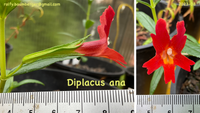Diplacus short tandem repeats* and "ear motif= GAAATGAGT" of all varieties in anthocyanin activating R2R3MYB2
see: Mimulus aurantiacus ecotype Red putative R2R3 MYB transcriptional regulator (Myb2) gene, complete cds Sequence ID: JX661264.1 Look up for this typical (...tctctctata...) string!
SRX6077409 PUN-LH19-2016 33.0609, -117.1188
D. puniceus
ear motif: yes
STR 2nd intron CTCTCTCTCTCTCTCTCTCTCTCTCTATATATATATATATATATATATATATATATATATAT±
TATA-length varies from individuum to individuum (15-24 TAs)
with ear motif, long hairpin
anthocyanin activating R2R3MYB2 is upregulated -> red flowers
D. ana hairpin?/EM?
The hairpin should be extended with an ear motif. The Subspecies has been in Statu Nascendi since 2010. More genomic background is needed in this case.
RUT_WTF (SRX19694291) 34.2174, -117.7630
Diplacus rutilus (longiflorus subspecies)
ear motif: GAAATGAGT
STR in 2nd intron:
TCCTCTCTCTCTCTCTCTCTCTCTCTCTCTCTATATATATATATATATATATATATATATATATATATATATATAT
hairpin: long
ear motif & long hairpin -->
Anthocyanin activating R2R3MYB2 is upregulated ->
dark red floral color
PAR-KK182 SRX6077455 34.0193, -119.6802 East of Prisoners Harbor
D. parviflora
ear motif: yes
in 2nd intron: hairpin with two stems and loop GTTAAT
GCCTAAAACTCTATCTGCCTGTCTATATATCTCGTTAAATGATATATAGACAGGCAGATAGAGTTTTAGGT
Anthocyanin activating R2R3MYB2 is upregulated ->
darker red floral color
very long mRNA hairpin
cf.
33.354895, -118.350723 Santa Catalina Island
Diplacus "catalina"
This Diplacus plant belongs to a separate variety. It is not a Diplacus parviflora. Here, some genomic analyses should also be done to clarify its status.
We expect an ear motiv here and long STRs in the first and second intron of the R2R3MYB2-Tf.
*****
We have yet to succeed in extending genomic studies in plants in transition. We aim to fulfill these studies to gain insight into this transition's molecular mechanism.
We mention what we have so far:
After cultivating an offspring of two yellow-flowered D. australis plants,
we got a light orange-flowered plant instead of a yellow one. It is not a F1-plant.
In the IGV (integrated genome viewer), we could make out a longer TATA string and an ear motif in some strings. Both, we did not expect. Some spontaneous altering took place during propagation, and that is what we followed.
Potrero_9-1-cult
To enlarge click on the pic
*****
SRX6077154 AUR-T92_6 37.8459, -120.6110 East of Oakdale
D. aurantiacus
CTCTCTCTCTCTCTCTCTCTCTCTCTCTCTCTCTCTCTATATATATATATATATATATTTATATATATATATATAT±
no ear motif, long hairpin --> activates aurone only
Anthocyanin activating R2R3MYB2 is downregulated -> golden yellow flowers
SRX6077462 LON-33_1 34.3438, -118.5099
San Fernando Pass Race D. longiflorus golden yellow
ear motif: no
STR in second intron:
TCCTCTCTCTCTCTCTCTCTCTCTCTCTCTCTCTCTCTCTCTATATATATATATATATATATATATATATATAT
no ear motif, long hairpin --> activates aurone only
Anthocyanin activating R2R3MYB2 is downregulated -> golden yellow flowers
SRX6077459 LON-T8_8 34.1347, -118.6452 Santa Monica Mts.
D. longiflorus
TCCTCTCTCTCTCTCTCTCTCTCTCTCTCTCTCTCTCTCTCTCTCTATATATATATAT±
no ear motif, short hairpin -->
Anthocyanin activating R2R3MYB2 is downregulated -> pale color to deep yellow;
SRX6077244 CAL-T90_2 35.5918, -118.5052 near Lake Isabella
D. calycinus
ear motif: no CTCTCTCTCTCTCTCTCTCTCTCTCTCTCTCTCTCTCTCTCTCATATATATATATAT
no ear motif, short hairpin -->
Anthocyanin activating R2R3MYB2 is downregulated -> yellow color
SRX6077239 GRA-T101_10 39.5536, -121.4301
grandiflorus
CTCTCTCTCTCTCTCTCTTAAATGATATATA
(pic from internet)
no ear motif, not a valid hairpin sequence -->
Anthocyanin activating R2R3MYB2 is downregulated -> yellow color
SRX6077405 PUN-POTR15-2016 32.6038, -116.6339 W of Potrero
D. australis
ear motif: no
CTCTCTCTCTCTATATATATATATATATA±
no ear motif; shorter hairpin
anthocyanin activating R2R3MYB2 is downregulated -> salmon yellow to deep yellow flwrs
SRX6077155 ARI-159 32.6630, -116.2230 near Iron Spring
D. aridus
ear motif: yes
CTCTCTCTCTCTCTCTCTCTCTCTCTCTATATATATATATATATAT
ear motif; short hairpin
anthocyanin activating R2R3MYB2 is downregulated -> pale yellow flowers
28.346337, -115.209025 Cedros Island Baja California
D. stellata.
We expect no ear motif and short or no hairpin here.
Genomic information needed.
herbarium specimen
SRX6077240 33.1589, -116.8122
D. clevelandii
CTCTCTCTCTCTCTCTCTCTCTCTCTCTCTCTCTCTCTCTCTCTATATATATATATATATAT±
no ear motif; short hairpin
anthocyanin activating R2R3MYB2 is downregulated -> yellow flowers to deep yellow flowers
The result is strikingly different from what is expected. The coding region (ex2) does not change over all diplacus varieties. On the contrary, in both introns,
a lot of pushmi-pullyu code (TATA) makes the difference.
In an evolutionary context, what is written in introns is more important than what is in exons and not vice versa.
https://www.youtube.com/watch?v=_JmA2ClUvUY
“TaTa-talking“!!!
*Such STRs in introns are not unique to Diplacus. They occur more frequently in autonomous regulating proteins in all plants.
Occurrence of Short Tandem Repeats in introns throughout the plant kingdom. 350 Taxa. Unpublished study (Schmid/Baumberger 2023)























